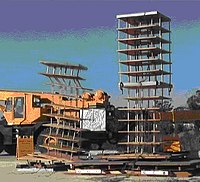
Photo from wikipedia
In this study, to overcome the construction drawbacks of conventional seismic retrofitting techniques, we proposed a new H-section steel frame (HSF) system for seismic strengthening of existing medium-to-low-rise reinforced concrete… Click to show full abstract
In this study, to overcome the construction drawbacks of conventional seismic retrofitting techniques, we proposed a new H-section steel frame (HSF) system for seismic strengthening of existing medium-to-low-rise reinforced concrete (RC) buildings. This HSF strengthening method exhibits excellent constructability because a control box is applied as a length adjustment device to cope with errors in the field associated with assembly works between the existing structure and reinforcing frame. The method represents a strength design approach implemented via retrofitting, to easily increase the ultimate lateral load capacity of RC buildings lacking seismic data, which exhibit shear failure. Two full-size two-story RC frame specimens were designed based on an existing RC building in Korea lacking seismic data, and then strengthened using the HSF system; thus, one control specimen and one specimen strengthened with the HSF system were used. Pseudodynamic tests were conducted to verify the effects of seismic retrofitting, and the earthquake response behavior with use of the proposed method, in terms of the maximum response strength, response displacement, and degree of earthquake damage compared with a control RC frame. Nonlinear dynamic analysis was performed based on the material properties of the test specimens, including a mathematical nonlinear hysteresis model to compare the results of the pseudodynamic tests. Test results revealed that the proposed HSF strengthening method, internally applied to the RC frame, effectively increased the lateral ultimate strength, resulting in reduced response displacement of RC structures under large-scale earthquake conditions. The nonlinear dynamic analysis and test results were in good agreement.
Journal Title: Bulletin of Earthquake Engineering
Year Published: 2020
Link to full text (if available)
Share on Social Media: Sign Up to like & get
recommendations!